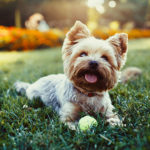
Winter is approaching – Can my dog get the cold?
Sniff, sniff, sniff
Who does not know it? A runny nose, a scratchy throat and that listlessness? It’s that time again – a cold is coming on. But it’s not just us humans who feel this way: our dogs do too. When a dog has a cold, however, he can’t shout it out into the world, let alone tell us. We have to take care of him ourselves and watch for signs. What signs should make your alarm bells ring and how to perfectly deal with your dog’s cold, we want to tell you here.
The cold season
After long walks and frequent wetting – whether by snow or rain – both dogs and owners are first of all frozen through. If the dog then also begins to sneeze, the question arises – does my dog have a cold? Because not only humans, but also dogs can fall ill and suffer from it. Especially in the cold seasons. However, not every cough or sneeze is a sign of a cold, let alone a case for the vet. Since many infections such as viruses, bacteria and fungi lead to rhinitis in dogs, we list for you which symptoms should make you sit up and take notice and what causes them.
Symptoms and causes: When your dog gets the cold
1. Sneezing
Sneezing can be harmless, but of course it can also be worrisome. Harmless sneezing often manifests itself after personal hygiene, licking, gnawing or rolling on the floor, but also when your dog does not know what is expected of him or what to do. When the situation overwhelms him. This sneezing is mostly one-time and not dangerous. Temporary irritation of the nasal mucous membranes caused by spraying cleaning products, deodorants, perfumes or even scented candles, can lead to sneezing. However, heavy and frequent sneezing should make you take notice.
2. Runny nose
If your dog has a runny nose in addition to frequent sneezing, this is the first sign that your dog has the cold. However, there are other reasons for a runny nose. For example, excitement and nervousness can cause a clear, thin mucus to come out of the nose. However, if this mucus does not disappear and the nose continues to run, this is another sign that your dog has the cold.
3. Foreign body
The symptoms of sneezing and a runny nose are also caused by foreign bodies stuck in your dog’s nose that he wants removed. In this case, your dog touches his nose with his paws and shakes his head more often than normal. In most cases, the foreign body is stuck in the nasal mucosa. In the long run, this can lead to chronic irritation and makes a visit to the vet essential. Romping around in fields, meadows and forests can cause small grains, grasses or ears of corn to get stuck in the nose and lead to cold-like symptoms.
4. Cough
A dog’s cough sounds different than a human’s. It sounds more like gagging, almost as if he is trying to gasp something out of his throat. Coughing can also have different causes. Infections caused by viruses or bacteria, as well as an irritated larynx from all the tugging on the leash and collar, can trigger such coughing fits. Nevertheless, when your dog has a cold, mucus accumulates in the nasal cavities and can either be excreted or flow through the throat area causing – as with us humans – choking and coughing.
5. Breathing sounds and mouth breathing
Due to your dog’s frequent sneezing fits, the nasal mucosa increasingly swells. This impedes breathing and leads to breathing noises. As a rule, dogs breathe through their nose. The exception is breathing through the mouth when running and playing wildly. If the nasal passages are blocked by the cold, your dog has no choice but to breathe through the mouth more often as normal.
6. Eye rubbing
Is your dog rubbing his eyes with his paws more often? This indicates an allergy. Allergies can have similar symptoms to the common cold and are not uncommon in dogs. Just like in humans, the cold-like symptoms can erupt at different times of the year. Common triggers include pollen, grasses, mold spores, dust and dust mites, as well as food ingredients, perfumes, cleaning products, rubber, plastic materials and more. Other signs may include chewing of the paws, scratching, licking and biting various parts of the body, ear infections, hair loss, coughing, red eyes with eye discharge and rubbing the eyes on various objects, as well as vomiting and diarrhea.
7. Nosebleeds
Dogs also sometimes suffer from nosebleeds. The causes here can be due to strong sneezing and foreign bodies in the nose, which lead to injuries of the mucous membranes. Less pleasant is the variant that it could be a benign or malignant tumor, which blocks the upper airways and thus triggers the rhinitis. Blood in the nasal secretions is also a possibility. If your dog has a nosebleed and it won’t stop, be sure to see a veterinarian.
8. Fever
A dog’s normal body temperature is 38.0 and 39.0 degrees Celsius (measured in the rectum), a bit higher than a human’s normal body temperature. If your dog has a cold and is listless, it is recommended to take a fever. With a temperature of 39.7 degrees Celsius, your dog is suffering from fever and it is advisable to consult a veterinarian.
9. Other symptoms
Other symptoms include, in particular, frequent licking of the nose, fatigue, vomiting and loss of appetite.
What can I do if my dog has the cold?
A few little tips for you:
1. Only take small walks and avoid wild playing and running.
2. Your dog needs to take it easy, so you should set up a stress-free environment so that he can sleep a lot and get some rest.
3. Warmth is good for both you and your pet when you have a cold. Set up a cozy corner for your four-legged friend, where he will be warm and quiet.
4. In winter, rooms are often dry. Not very conducive to a cold. To increase the humidity in the room, you can use a humidifier or turn off your dehumidifier, hang wet towels over the heater, or as a short-term solution, dry your laundry in this room.
5. Your dog needs to drink a lot!
6. Especially for a dog with a cold , high quality and high protein food is very important, which contains many nutrients. Buy appropriate food for your dog. Tip: If your dog drinks too little, enrich the food with water, so that he at least takes liquid about it.
7. If your dog has a cough, you should put a scarf on him.
8. Clean the nose! Liquid irritates the skin and incrustations are a nuisance. Remove the incrustations with lukewarm saline solution and apply dog care cream to the areas. Creams that are especially good for your dog include shea butter, almond or jojoba oil and vitamin E or in other cases Vaseline.
9. If you have a sick puppy (under 12 months) or a recently adopted dog, it’s a good idea to see your vet immediately. Even with an originally fit dog, a visit to the vet can’t hurt.
10. Since dogs get sick from the same type of pathogens, you should first prohibit or limit your dog’s contact with other dogs.
11. Do not give your dog any human medication. Even if you mean well, it can be toxic for your dog. Only use the medication that your vet prescribes for your furry friend.
12. You can put fennel honey under the food or in the water. Attention: Only for adult dogs and not for puppies!
13. Inhalation. As with humans, inhalation also helps your dog. You can either use water with sea salt, different kinds of tea or dried chamomile flowers or dried thyme stalks. Put them in a bowl with 2-3 liters of hot water. Please do not use essential oils as they may be toxic. Procedure: If your dog is used to transport boxes, you can put him in them, place the bowl at a safe distance in front of the box and put a large towel over it, creating an inhalation cave. If you don’t have a transport box handy, you can sit with your dog next to the bowl and make sure he inhales the vapors. While this is not as effective as the inhalation cave, it also helps.
How long does a dog cold last?
How long your dog has a cold depends on three factors:
1. The cause
There are hundreds of different viruses, fungi and parasites. Each pathogen is different and affects your dog differently. So it depends on your dog and his immune system whether he gets sick from it or not. Some pathogens do not cause much more than a cold, while others lead to serious illnesses and their recovery processes take correspondingly longer.
2. The ability to defend
If your dog has a cold, the duration depends on what physical condition he is in and how old he is. Older animals, puppies or animals already weakened for other reasons, have longer to fight with a cold than fit, well-fed and rested animals.
3. The treatment
Treatment plays a particularly crucial role in an illness. If a veterinarian is consulted, who will start the appropriate treatment for your dog, it will of course depend on whether or not you stick to what has been said. If the dog does not get enough rest and is spared, the disease will also last longer. The same applies to wrong diagnoses and treatments on the part of the veterinarian – here always remember: veterinarians are only human and can make mistakes. Complications during treatment can result in a longer duration of the cold. With proper treatment, however, the cold should soon be over.
So what does this mean?
When a dog has the cold, a range of a few days to several weeks can be expected. Generally, a visit to the veterinarian is recommended. Especially for puppies and for inexperienced pet owners. Dog rhinitis, unlike a cold in humans, is a serious disease and should be treated accordingly. Only the veterinarian can estimate how long the treatment and the disease will last. Despite an appointment for follow-up, you can always visit the vet again if symptoms worsen or you have an “uneasy” feeling in your stomach. After all, this is about your darling!
Is it contagious if my dog has the cold?
No, basically it is not contagious. Humans can – especially in the cold season – also get sick from viruses and get a cold, but these are different cold viruses. A transmission and risk of infection is not to be expected. Neither from dog to human, nor from human to dog. However, dogs are contagious among themselves, because they have the same type of cold virus. It is therefore advisable to initially limit or completely avoid contact with other dogs.
How do I prevent dog colds?
Dogs also have a higher need for vitamins and fatty acids during cold season. This should be urgently taken into account when feeding. In addition, to strengthen the immune system, preparations such as echinacea, vitamin C and aloe vera can be administered – preferably through the food. Also the above mentioned improvement of the breathing air can help to prevent rhinitis. For this purpose, you can set up humidifiers to avoid particularly dry rooms. Attention: Do not use room fragrances, sprays or incense sticks. Especially in winter, dogs with simple hair, without undercoat or with very short coat should wear a dog coat. You should avoid clipping or bathing in winter. If your dog does get wet on the way, you should dry him well and provide him with a warm place. Since in winter often with road salt or grit is strewn, it is advisable to care for the paws after the walk. To do this, cut claws and the fur of the paws and put paw protection balm on the pads. Make sure that your dog does not eat snow that is very close to road salt or grit, as these can be highly contaminated up to toxic.
Conclusion: dog cold
Basically, first of all – no need to panic. Intermittent sneezing is completely normal for dogs. A light dog rhinitis can be helped with the help of home remedies. If several of the symptoms described above occur more frequently and do not disappear even after two days and all kinds of home remedies, you should consult a veterinarian. Especially in the case of puppies, old dogs and those that have already been affected for various reasons. The veterinarian will advise you on the best ways of treatment and ways to get your four-legged friend back on his paws quickly. The instructions are to be followed absolutely, so that you and your darling can go quickly again carefree and healthy through thick and thin.









